How To Make Thai Crispy Fried Chicken
Thai Crispy Fried Chicken isn’t just a dish; it’s a cultural phenomenon. Known locally as “Gai Tod”, this street food classic captures everything people love about Thai cuisine bold flavors, aromatic marinades, and that signature crispy skin. At JustThaiRecipes, we’re passionate about bringing authentic Thai dishes to kitchens around the world.
It all started with Lina’s story on the About page, where she shared her journey of falling in love with Thai street food while traveling through Bangkok’s bustling markets. From trying her first crispy fried chicken in Chiang Mai to recreating it in her own kitchen, Lina’s mission became clear: to help others experience these flavors at home. This article will walk you through everything you need to know about Thai Crispy Fried Chicken, from its origins to step-by-step cooking tips that guarantee success.
Looking for inspiration? Try our Thai Green Chicken Curry recipe for a cozy, aromatic meal that pairs beautifully with crispy fried chicken.
Table of Contents
Table of Contents
Understanding Thai Crispy Fried Chicken
The Cultural Significance of Thai Crispy Fried Chicken
When you stroll through the lively streets of Thailand, the sound of sizzling oil and the aroma of marinated chicken frying in woks is impossible to ignore. Thai crispy fried chicken has a long history tied to Southern Thai cooking, where Muslim communities first introduced fried chicken recipes influenced by Malay and Indonesian cuisines. Over time, it evolved into a uniquely Thai creation. Vendors use marinades rich with garlic, cilantro roots, fish sauce, and white pepper to infuse layers of flavor before the chicken ever touches the hot oil.
Unlike its Western counterpart, Thai fried chicken is often served with sticky rice and a side of sweet chili sauce. This combination makes it a convenient street food meal, easy to eat on the go and incredibly satisfying. In Thailand, the dish is a symbol of comfort, celebration, and culinary ingenuity.
Street food stalls often top their servings with crispy fried shallots, adding another layer of texture and a subtle sweetness that complements the savory chicken perfectly. This small touch sets Thai crispy fried chicken apart from typical fried chicken recipes.
How Thai Crispy Fried Chicken Differs From American Fried Chicken
At first glance, you might think fried chicken is the same worldwide. But Thai crispy fried chicken stands out because of its preparation and ingredients. Let’s break down how it differs:
| Feature | Thai Crispy Fried Chicken | American Fried Chicken |
|---|---|---|
| Batter/Base | Thin rice flour batter | Thick flour and buttermilk batter |
| Flavor Profile | Herbal, garlicky, savory umami | Spicy, peppery, buttery |
| Marinade | Fish sauce, soy sauce, garlic, cilantro | Buttermilk, salt, pepper |
| Serving Style | With sticky rice and fried shallots | With biscuits, gravy, or alone |
| Crispiness | Light, shattering crisp | Heavier, crunchy crust |
Rice flour is the secret ingredient that gives Thai fried chicken its light and crispy texture. This flour creates a thinner coating that doesn’t soak up as much oil, leaving a delicate, crunchy exterior that stays crisp even after cooling.
Additionally, the marinade plays a crucial role. Fish sauce and soy sauce bring umami depth, while cilantro roots and garlic provide fresh, earthy undertones. It’s a balance of flavors that’s distinctly Thai.
Another unique element is how the chicken is scored before marination. Small incisions allow the marinade to penetrate deeper into the meat, resulting in a juicy, flavorful bite all the way to the bone.
Why Thai Crispy Fried Chicken Is Perfect for Home Cooks
You might think that achieving restaurant-level Thai crispy fried chicken at home is complicated, but the process is surprisingly simple. With just a few key ingredients and some frying tips, anyone can recreate this dish.
Here’s why home cooks love it:
- Minimal Ingredients: Most elements are pantry staples or easily available in Asian markets.
- Quick Frying Time: Small cuts like wings or drumsticks cook in under 15 minutes.
- Versatility: It pairs well with multiple side dishes like papaya salad or sticky rice.
- Make-Ahead Marinade: You can marinate the chicken overnight for maximum flavor and minimal prep on cooking day.
Authentic Thai crispy fried chicken isn’t overly greasy. The rice flour batter absorbs less oil, which means you can enjoy a guilt-free crispy snack or meal.
Popular Variations Around Thailand
While “Gai Tod” is the most common version, different regions in Thailand offer unique spins on fried chicken:
- Hat Yai Fried Chicken: Originating from southern Thailand, this variation is famous for being topped with extra fried shallots and served with sticky rice.
- Gai Tod Kratiem Prik Thai: A garlicky, peppery fried chicken that skips the batter altogether for a more rustic approach.
- Thai-Style Chicken Chinese: A fusion style often served in Bangkok’s Chinatown with soy-based marinades and five-spice seasoning.
Exploring these variations adds more depth to your culinary adventures and can inspire you to tweak your own recipes at home.
Pairing Suggestions for a Complete Meal
Thai crispy fried chicken is rarely eaten alone. Sticky rice is the traditional sidekick, perfect for balancing the savory flavors of the chicken. For dipping, sweet chili sauce reigns supreme, but spicy tamarind sauce or sriracha mayo also make excellent pairings.
You can even elevate your meal by serving it with a refreshing papaya salad (Som Tum) for a classic Thai street food combination.
For dessert? Why not a Thai mango sticky rice to end your meal on a sweet note.
Check out our Cashew Chicken Thai Style for a quick and easy weekday dinner that captures Thai flavors beautifully.
Thai Crispy Fried Chicken Recipe You Can Try at Home
If you’ve ever wanted to recreate the crunchy, golden perfection of Thai Crispy Fried Chicken in your kitchen, this is your chance. With the right marinade, batter, and frying techniques, you can enjoy authentic street food flavors without leaving home. This recipe follows the traditional methods used by Thai vendors while being adapted for home cooks. Whether you’re craving authentic Thai crispy fried chicken or a quick and easy version, you’ll find all the steps here.
Ingredients You’ll Need for Authentic Thai Crispy Fried Chicken
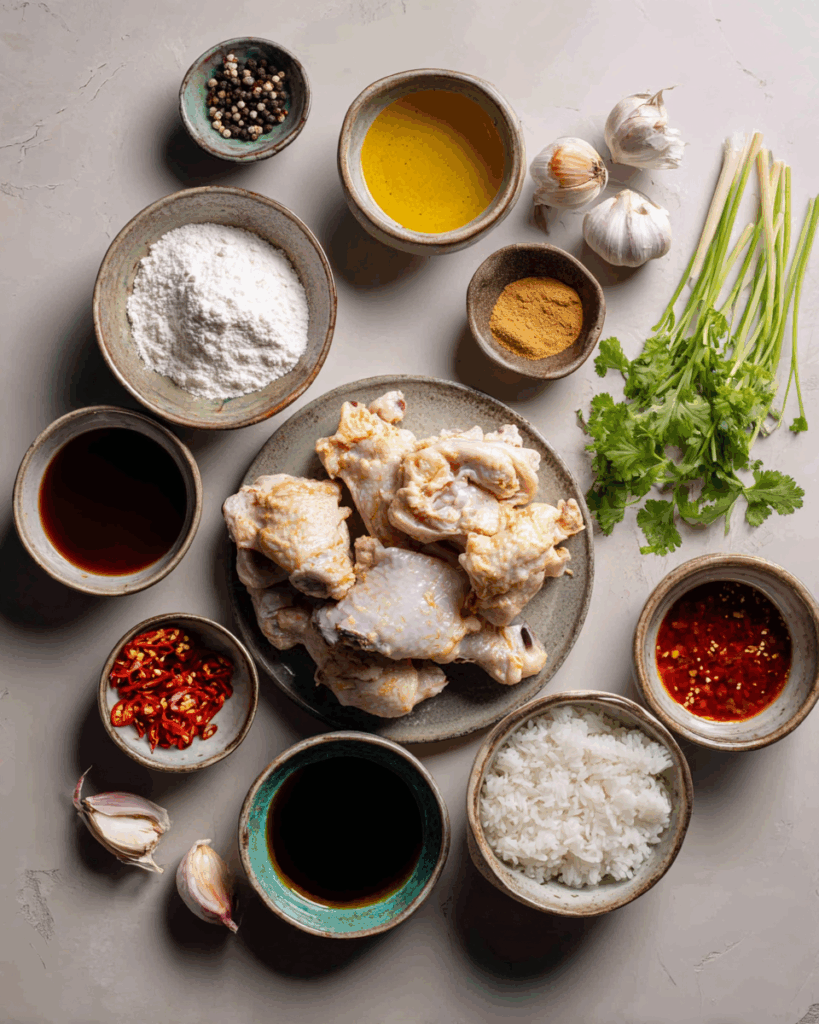
Before you begin, gather these ingredients. They’re easy to find in Asian grocery stores or online and are the foundation for the perfect fried chicken:
- 1 ½ lb bone-in, skin-on chicken (thighs or drumsticks recommended)
- 5 cloves garlic
- 8 cilantro stems, chopped
- ¾ teaspoon white peppercorns (black pepper works in a pinch)
- 2 ½ teaspoon sugar
- 2 tablespoon Thai soy sauce
- 1 tablespoon fish sauce
- ½ cup water
- 1 cup rice flour
- Oil for frying (vegetable or peanut oil preferred)
- Fried shallots (store-bought or homemade, optional)
- Sticky rice and sweet chili sauce for serving (optional but highly recommended)
Pro Tip: Rice flour creates a light, crisp texture that stays crunchy. Avoid substituting with wheat flour.
Step-by-Step Instructions for Crispy Perfection
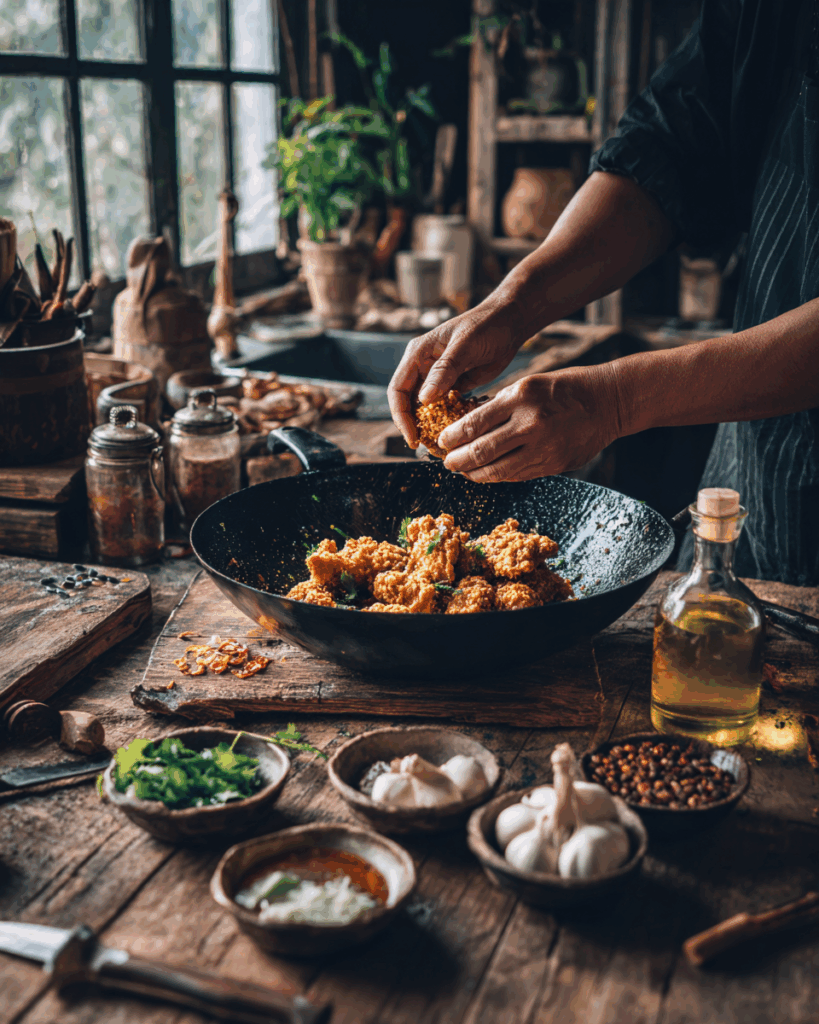
Mastering Thai crispy fried chicken comes down to three key phases: marinating, preparing the batter, and frying.
Step 1: Prepping and Marinating the Chicken
- Score the Chicken
- For drumsticks: Make 1 cm deep cuts on the thickest parts of the meat to help the marinade penetrate and ensure even cooking.
- For thighs: Trim excess skin and make small incisions near the bone.
- Make the Marinade Paste
- Using a mortar and pestle, pound the white peppercorns until fine. Add garlic and cilantro stems, pounding into a smooth paste. Stir in sugar to grind the herbs further.
- Combine Marinade Ingredients
- In a large bowl or zip-top bag, mix the garlic-cilantro paste with Thai soy sauce, fish sauce, and water. Add the chicken pieces, ensuring each piece is fully coated.
- Marinate
- Cover and refrigerate for at least 4 hours. For best results, let it marinate overnight. Turn the chicken halfway through to ensure even flavor distribution.
Step 2: Preparing Fried Shallots (Optional But Worth It)
- Slice the Shallots
- Slice shallots crosswise into 2mm thick pieces. Sprinkle with a pinch of salt and toss to draw out moisture. Let sit for 10 minutes.
- Dry the Shallots
- Place them on a paper-towel-lined plate and press another layer on top to absorb excess water.
- Fry the Shallots
- Heat about 2 inches of oil in a wok or large pot over medium heat. Once hot, test-fry a single shallot slice. When bubbles surround it steadily, reduce heat to low and add the rest. Fry for 5–8 minutes, stirring frequently until golden.
- Drain and Set Aside
- Scoop out with a wire skimmer and let them drain on paper towels. The shallots will darken slightly as they cool.
These crispy shallots add a sweet crunch that pairs beautifully with the savory fried chicken.
Step 3: Coating and Frying the Chicken
- Prepare the Batter
- Transfer marinated chicken into a mixing bowl. Add about ¾ cup of rice flour, mixing well to form a thin, lump-free batter that lightly coats each piece. Add more rice flour or a splash of water as needed.
- Heat the Oil
- Heat 2 inches of oil in a wok or large pot to 375°F (190°C). Once ready, gently lower half of the chicken pieces into the oil.
- Adjust Temperature
- Allow the oil temperature to drop to about 300°F (150°C) and maintain it there. This ensures the chicken cooks through without burning the exterior.
- Fry the Chicken
- Fry drumsticks and thighs for 10–12 minutes or until dark meat reaches 175°F (79°C) internally. Wings cook faster in about 6–8 minutes. Flip every 1–2 minutes for even browning.
- Drain and Rest
- Remove chicken from the oil with a skimmer and let it rest on a paper-towel-lined plate for 5–10 minutes. This allows juices to redistribute and the crust to set fully.
Pro Tips for Perfect Thai Crispy Fried Chicken
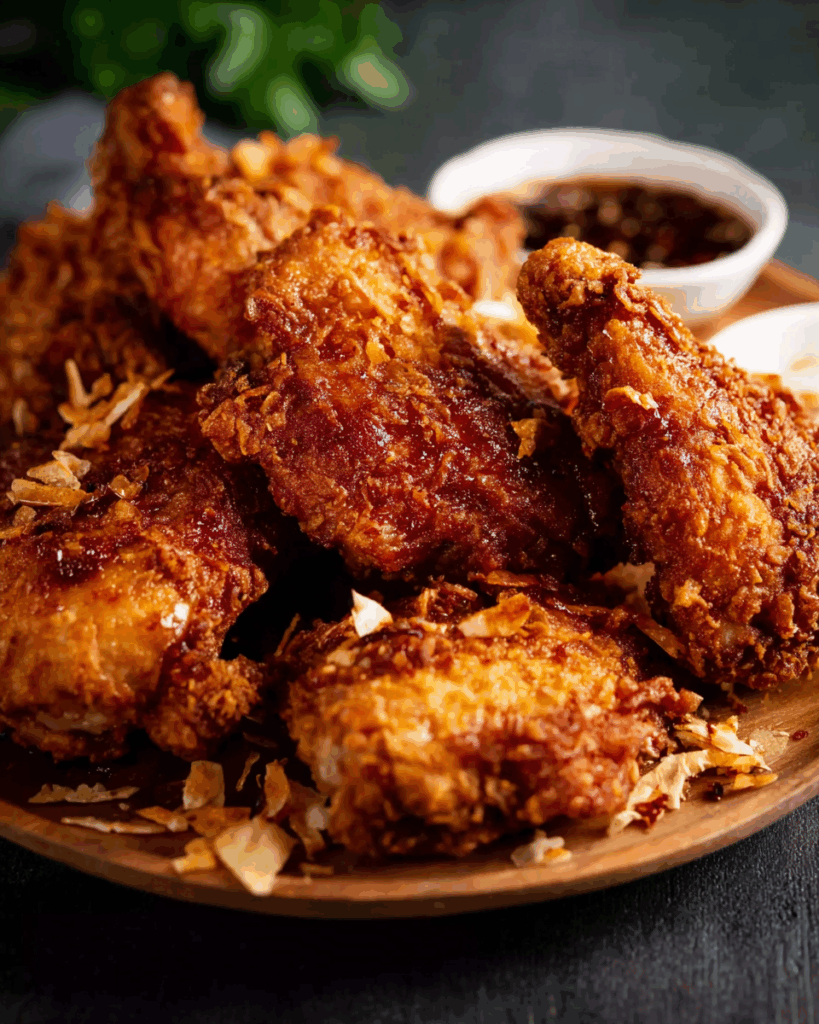
- Don’t Overcrowd the Pan: Fry in batches to keep the oil temperature consistent.
- Use a Thermometer: Maintaining the right oil temperature is crucial for crispy results.
- Rest After Frying: This keeps the chicken juicy and avoids burning your mouth from trapped steam.
Serving Your Thai Crispy Fried Chicken
Serve your Thai crispy fried chicken with sticky rice and sweet chili dipping sauce for an authentic experience. Top with fried shallots for added flavor and texture. You can also serve it with fresh cucumber slices or a tangy Thai salad to balance the richness of the fried chicken.
Discover great ideas like our Red Thai Crispy Chicken Curry if you’re in the mood for a saucier Thai chicken dish.
Why This Recipe Works Every Time
This method ensures crispy, golden chicken every single time thanks to:
- A flavorful marinade that penetrates deep into the meat.
- Rice flour coating for that signature light crunch.
- Temperature control during frying for evenly cooked, juicy chicken.
It’s no wonder this recipe is loved by home cooks looking for a reliable and authentic Thai crispy fried chicken recipe easy enough for weeknights yet impressive for guests.
Secrets To The Ultimate Crunch
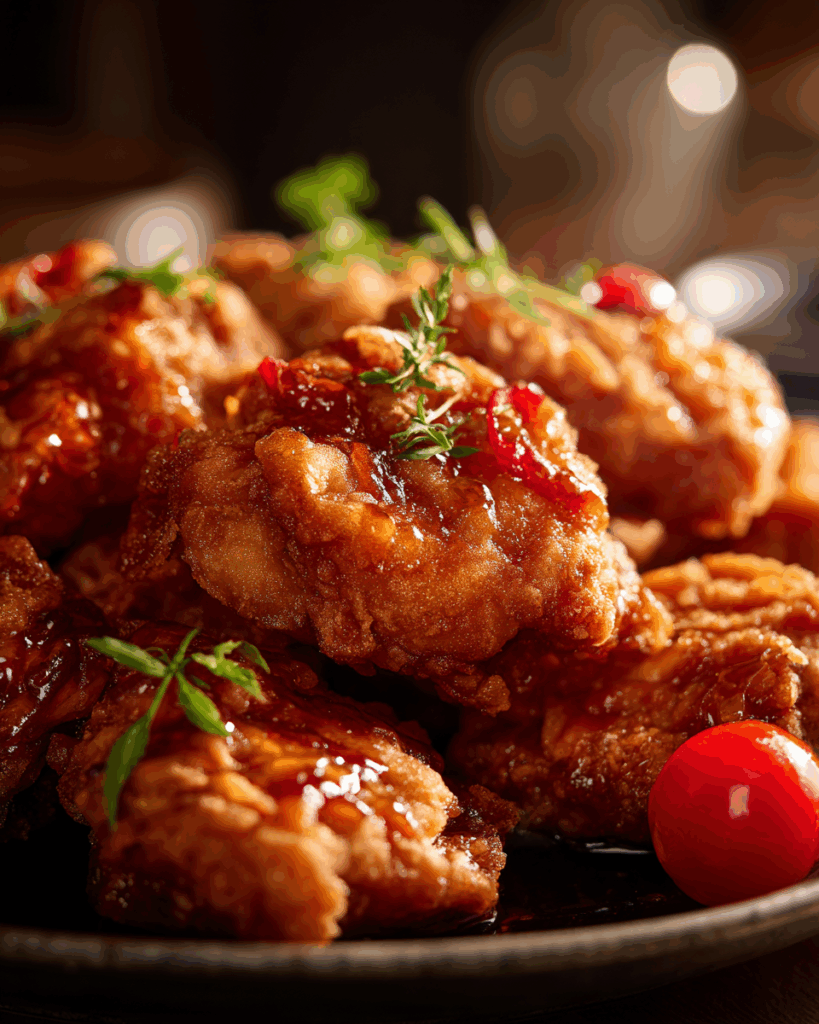
Achieving the ultimate crunch in Thai crispy fried chicken isn’t magic—it’s science. From the right batter to perfect frying temperatures, each step plays a role in creating that satisfying shatter when you bite into the golden crust. Home cooks often wonder why their fried chicken turns soggy minutes after leaving the oil. The answer lies in understanding what makes Thai fried chicken stand out from Western styles and mastering a few simple techniques.
What Makes Thai Fried Chicken So Crispy?
The secret ingredient in authentic Thai crispy fried chicken is rice flour. Unlike wheat flour, rice flour forms a lighter, airier crust that doesn’t absorb excess oil. This means your chicken stays crisp even after cooling. Many street vendors also add a pinch of cornstarch or tapioca flour to enhance the crunch factor.
According to Serious Eats (source), starches like rice flour gelatinize differently than gluten-based flours, creating a more brittle, glass-like crust that shatters on the first bite. This is why Thai fried chicken has that signature crispness while remaining light and not greasy.
Another tip? Letting the batter rest for a few minutes before frying allows the rice flour to hydrate fully, leading to an even coating on the chicken.
Temperature Control: The Key To Crispiness
Perfect Thai crispy fried chicken isn’t about frying hotter—it’s about frying smarter. Keep the oil at a steady 300°F (150°C) after the initial sizzle. If the oil is too hot, the exterior will burn before the inside cooks through. Too cold, and the chicken will soak up oil, becoming greasy.
A deep-fry thermometer is your best friend here. For those without one, test the oil by dropping in a small piece of batter—it should sizzle immediately and float to the top with bubbles surrounding it.
As noted by The Kitchn (source), maintaining oil temperature is critical not only for crispiness but also for food safety, ensuring chicken cooks evenly to the bone.
The Role of Marination in Crispiness
Did you know that a good marinade doesn’t just flavor the chicken—it also helps with crispiness? Garlic, cilantro roots, fish sauce, and soy sauce all contain natural sugars and amino acids. When fried, these components caramelize slightly, creating a flavorful, golden crust.
Avoid overly wet marinades, though. Excess liquid can dilute your batter. Pat the marinated chicken dry before coating it with rice flour for a better crunch.
For an extra layer of flavor and texture, some Thai chefs coat marinated chicken in panko breadcrumbs after dipping in rice flour batter. While not traditional, it’s a great hack for home cooks who prefer an ultra-crispy bite.
Why Resting Fried Chicken Is Non-Negotiable
Once your Thai crispy fried chicken comes out of the oil, let it rest on a wire rack over a baking sheet. This prevents the crust from steaming and softening against paper towels. Resting also allows the juices to redistribute, so you don’t lose flavor when you take that first bite.
Serious Eats recommends this technique for any fried food to preserve texture (source).
Common Mistakes to Avoid
Even seasoned cooks can make errors that sabotage crispy chicken. Here’s what to watch for:
- Overcrowding the Pan: This drops the oil temperature, leading to greasy, soggy crusts. Fry in small batches instead.
- Skipping the Rice Flour: Using all-purpose flour will result in a denser coating that doesn’t stay crisp. Stick with rice flour for authentic texture.
- Not Flipping Enough: Turn the chicken every 1–2 minutes to promote even browning.
- Skipping the Rest: Let the chicken rest for 5–10 minutes post-fry to preserve its crunch.
Troubleshooting: Why Isn’t My Chicken Crispy?
| Problem | Possible Cause | Solution |
|---|---|---|
| Soggy crust | Oil too cold or wet marinade | Heat oil to 375°F; pat chicken dry |
| Uneven browning | Crowded pan or inconsistent flipping | Fry in batches; flip regularly |
| Burnt exterior, raw interior | Oil too hot | Lower heat to maintain 300°F |
| Crust falls off | Batter too thick or over-handled | Use a thin batter; handle gently |
Learn more about frying techniques on America’s Test Kitchen for additional tips.
The Science Behind Staying Crisp
What makes Thai crispy fried chicken resist sogginess? The thin rice flour batter creates a micro-layer of crispness that cools quickly without absorbing moisture. By comparison, thicker American-style batters trap steam underneath, softening the crust.
Some street vendors also double fry their chicken for extra crunch. The first fry cooks the chicken through, and a quick second fry at higher heat crisps up the skin beautifully. If you’re serving chicken later, this method is ideal.
Bonus Tip: Using Fried Shallots for Extra Texture
Thai fried chicken is often garnished with fried shallots. Their sweet, caramelized crunch complements the savory chicken perfectly. Making them at home takes just a few minutes and elevates the dish from great to unforgettable.
Don’t miss our Thai Green Chicken Curry for a comforting side that pairs beautifully with fried chicken.
Marinade Magic – The Heart of Thai Fried Chicken
When it comes to making Thai Crispy Fried Chicken unforgettable, the marinade does most of the heavy lifting. This isn’t just about coating the surface of the meat with flavor—it’s about infusing every juicy bite with the essence of Thai cuisine. The aromatic blend of garlic, cilantro roots, fish sauce, and soy sauce creates a deeply savory profile that sets Thai fried chicken apart from other styles.
Why Marinade Matters in Thai Cooking
In Thai street food culture, marinades aren’t just optional; they’re essential. Unlike some Western recipes where seasoning happens mainly in the batter, Thai crispy fried chicken depends on hours of soaking in a flavorful mixture. This allows the chicken to absorb both surface and deep internal flavors.
The combination of umami-rich fish sauce and slightly sweet soy sauce forms a balanced base, while the fresh cilantro roots and crushed garlic bring a herbal earthiness and a sharp, aromatic kick. The inclusion of white pepper adds subtle heat without overpowering the other flavors.
Each ingredient in the marinade contributes something special:
- Garlic gives pungency and a touch of sweetness when fried.
- Cilantro roots offer a unique, earthy freshness not found in the leaves.
- Fish sauce delivers the signature Thai umami depth.
- Soy sauce balances saltiness with slight caramel notes.
- Sugar enhances browning and adds a hint of sweetness.
When these elements work together, they create a marinade that not only flavors but also tenderizes the chicken.
Tips for the Perfect Marinade
To maximize the flavor impact of your marinade, follow these expert tips:
- Use Fresh Ingredients: Fresh garlic and cilantro roots produce stronger aromatics than dried or pre-minced alternatives.
- Pound, Don’t Chop: Using a mortar and pestle to crush garlic, cilantro roots, and peppercorns releases essential oils for a more potent marinade.
- Time Is Your Friend: Marinate for at least 4 hours, but overnight marination gives the best results, allowing flavors to penetrate deeply.
- Score the Meat: Making small incisions in thick pieces of chicken helps the marinade seep into the densest parts.
Common Marinade Mistakes to Avoid
Even a good marinade can fail if not handled properly. Here are common pitfalls and how to avoid them:
- Too Much Liquid: A watery marinade can prevent the batter from sticking later. Keep it thick enough to coat the chicken without pooling excessively.
- Skipping the Pat-Down: After marinating, pat the chicken dry with paper towels before dredging in rice flour. Excess moisture causes splattering and a soggy crust.
- Underseasoning: Don’t be shy with aromatics and sauces. Thai food thrives on bold, unapologetic flavors.
Marinade Variations To Try
While the traditional marinade is a classic, experimenting with slight variations can create exciting new flavor profiles:
- Spicy Kick: Add finely minced Thai bird’s eye chilies for heat lovers.
- Fragrant Lemongrass: Include crushed lemongrass stalks for a citrusy note.
- Sweet and Sticky: Incorporate a spoonful of palm sugar for a subtle caramel glaze effect during frying.
These small adjustments allow you to tailor the dish to your personal taste or even create multiple versions for a family dinner spread.
Why Thai Marinade Equals Juicier Chicken
Beyond flavor, the marinade plays another critical role: locking in moisture. The salty components of fish sauce and soy sauce draw some moisture out of the meat at first, but as the process continues, the brine effect allows the chicken to reabsorb seasoned liquid. This means that even after deep frying, the chicken remains tender and juicy inside, contrasting beautifully with its crispy exterior.
The marinade also helps the surface sugars caramelize during frying, enhancing the golden-brown color and creating subtle layers of flavor in the crust.
Making the Marinade a Meal Prep Staple
The beauty of this marinade isn’t limited to chicken. You can use it for other proteins like pork, shrimp, or even tofu to infuse them with Thai flavors. Marinate, grill, or fry—each method delivers a satisfying result.
For busy weeknights, double the marinade recipe and store it in an airtight container in the fridge for up to 3 days. When the craving for Thai crispy fried chicken strikes, you’ll be halfway to dinner already.
The Heartbeat of Thai Crispy Fried Chicken
In the end, the marinade isn’t just a step in the process—it’s the soul of the dish. It captures the balance of sweet, salty, herbal, and umami that makes Thai cuisine so universally loved. Mastering this one element brings you closer to recreating the bustling flavors of a Thai street market right at your dinner table.
Thai Crispy Fried Chicken Variations You’ll Love
While the classic Thai crispy fried chicken is a masterpiece in itself, Thai cuisine thrives on creativity and adaptability. Across Thailand, cooks have reimagined this street food favorite into exciting variations that bring new textures, flavors, and even cooking methods to the table. From bold spicy twists to lighter stir-fried adaptations, these delicious alternatives will inspire you to experiment in your own kitchen.
Hat Yai Fried Chicken: A Southern Thai Classic
Hat Yai Fried Chicken is a well-known regional variation that originated in southern Thailand. This version is famous for its use of fried shallots sprinkled generously over the chicken, adding sweetness and crunch. The marinade often includes turmeric and coriander seeds, giving the chicken a rich, golden color and a subtle earthy aroma.
This style is almost always paired with sticky rice, making it a complete meal that’s both satisfying and easy to enjoy on the go.
Thai Crispy Fried Egg: A Quick and Crunchy Snack
If you’re looking for a simpler, vegetarian-friendly alternative, the Thai crispy fried egg is the perfect choice. The concept is similar—high heat, sizzling oil, and a focus on crisp textures. The egg is cracked directly into very hot oil, creating a lacy, golden edge that contrasts beautifully with the soft, runny yolk in the center.
This snack is often served with jasmine rice and a drizzle of sweet soy sauce for a comforting yet quick meal. It’s proof that Thai cooking can transform even the simplest ingredients into something spectacular.
Thai Crispy Chicken Stir Fry: A Weeknight Hero
One of the most practical ways to enjoy leftovers of Thai crispy fried chicken is to turn them into a stir fry. Sliced pieces of the fried chicken are tossed in a hot wok with garlic, Thai chilies, basil leaves, and a splash of fish sauce.
This approach gives you a dish that’s lighter than deep-frying yet retains the signature Thai flavors. It’s perfect for busy weeknights when you want something fast but packed with bold taste.
Thai-Style Chicken Chinese Fusion
In Bangkok’s Chinatown, you’ll often find a fusion version of crispy fried chicken influenced by Chinese cooking techniques. This variation might include a soy-based marinade seasoned with five-spice powder, creating a complex flavor profile with hints of star anise, cinnamon, and cloves.
The batter here tends to be slightly thicker, using a mix of rice flour and cornstarch for a crisp yet slightly chewy coating. This style is often served with steamed jasmine rice and stir-fried greens for a balanced plate.
Sweet and Spicy Crispy Chicken: A Modern Twist
For those who crave a bit of heat, a sweet and spicy glaze can elevate traditional Thai crispy fried chicken. After frying, the chicken is tossed in a sticky sauce made from Thai chilies, tamarind paste, and palm sugar. This creates a glossy coating that clings to every piece, balancing fiery heat with sweetness and tang.
This variation is popular among younger Thai food enthusiasts who enjoy bold, modern flavors while still appreciating traditional cooking methods.
Family-Friendly Popcorn Thai Chicken
Another creative take is bite-sized popcorn Thai chicken. Small chicken pieces are marinated as usual, then coated in rice flour and deep-fried until golden. The result? Crispy, snackable pieces perfect for dipping into sweet chili sauce or spicy sriracha mayo.
This style is a hit at parties or as an appetizer and can easily be adapted for air frying to reduce oil use while keeping the crunch.
Why These Variations Work
Each variation stays true to the essence of Thai crispy fried chicken by maintaining key elements: a flavorful marinade, crisp coating, and balance of textures. Yet, they also showcase how Thai cooking celebrates diversity and innovation, making it easy to tailor the dish to personal preferences or dietary needs.
Experiment With Your Own Twist
Part of the fun of Thai cooking is how forgiving and flexible it can be. Consider experimenting with different spices, herbs, and even cooking oils to create a signature version of Thai crispy fried chicken that suits your palate. Whether you love it extra spicy, garlicky, or with a touch of sweetness, there’s room to make it uniquely yours.
Pairing Thai Crispy Fried Chicken With Traditional Sides
Great food becomes unforgettable when paired with the right accompaniments, and Thai crispy fried chicken is no exception. While this golden, crunchy masterpiece can stand on its own, Thai street vendors and home cooks alike know that sides are essential for creating a balanced, satisfying meal. From fragrant sticky rice to vibrant salads, the supporting players on your plate elevate the fried chicken experience to a whole new level.
Sticky Rice: The Quintessential Companion
In Thailand, sticky rice—known as khao niao—is more than a side dish; it’s a tradition. This chewy, slightly sweet rice acts as the perfect foil to the savory, umami-rich flavors of Thai crispy fried chicken. Its soft texture contrasts beautifully with the chicken’s crisp coating, and it’s often used to scoop up pieces of chicken without the need for utensils.
The simplicity of sticky rice allows the complex flavors of the marinated chicken and fried shallots to shine. To serve, keep the rice warm and in small individual portions, wrapped in banana leaves for an authentic touch.
Fried Shallots: Crunch on Crunch
Fried shallots are a secret weapon in Thai cooking, and they’re often scattered generously over plates of crispy fried chicken. These thinly sliced shallots, fried until golden and fragrant, bring a sweet and nutty flavor that enhances the chicken’s savory notes. The added crunch creates a delightful texture contrast with every bite.
If you’re making them at home, prepare a large batch—they store well and can also be used to top soups, salads, or even plain rice dishes.
Sweet Chili Sauce: The Perfect Dip
No plate of Thai crispy fried chicken feels complete without a small bowl of sweet chili sauce on the side. This condiment balances the chicken’s savory richness with a sweet and tangy heat that cuts through the oiliness.
You can easily find bottled Thai sweet chili sauce at most supermarkets, but homemade versions often include a fresher, brighter flavor. Simply simmer Thai chilies, sugar, vinegar, garlic, and water until slightly thickened for a dipping sauce that pairs perfectly with every crispy bite.
Green Papaya Salad (Som Tum): A Fresh Counterpoint
To lighten up the meal, a side of green papaya salad offers a refreshing burst of flavor. This tangy, slightly spicy salad features shredded unripe papaya tossed with lime juice, fish sauce, chilies, and roasted peanuts. The crisp, cool texture of the salad contrasts with the hot, crunchy chicken, creating a perfect balance on your plate.
This combination of crispy, juicy chicken and fresh, zingy salad mirrors the way street food vendors serve fried chicken across Thailand.
Thai Cucumber Relish: Cooling and Crisp
For a milder accompaniment, Thai cucumber relish (ajad) is another excellent choice. This side dish features thinly sliced cucumbers, red onions, and chilies in a sweet vinegar dressing. Its cool, crunchy texture and slightly tangy flavor act as a palate cleanser between bites of the rich, flavorful chicken.
Coconut Rice: A Creamy Alternative
For those seeking a touch of luxury, coconut rice makes a decadent pairing. Cooked with coconut milk, this fragrant rice has a subtle sweetness and creamy texture that complements the spicy undertones of Thai crispy fried chicken beautifully.
Why Pairings Matter
These sides aren’t just afterthoughts—they are carefully chosen elements that enhance the fried chicken’s appeal. Thai cuisine is all about harmony and contrast: spicy meets sweet, crunchy meets soft, and rich meets refreshing. Pairing your chicken thoughtfully brings out all these dimensions in one memorable meal.
Build Your Own Thai Street Food Platter
If you’re hosting a dinner or just want to recreate a true Thai street food experience, consider serving:
- A plate of Thai crispy fried chicken as the centerpiece
- Small bowls of sticky rice and coconut rice for variety
- Fried shallots for sprinkling
- Sweet chili sauce and Thai cucumber relish as dipping options
- A fresh green papaya salad for a burst of color and flavor
This combination offers a perfect balance of flavors and textures, ensuring every bite keeps your guests coming back for more.
The Art of the Perfect Bite
The ultimate Thai crispy fried chicken experience isn’t just about the chicken—it’s about crafting the perfect bite. A small piece of chicken with a pinch of sticky rice, a fried shallot topping, and a dip in sweet chili sauce creates a harmonious blend of crispy, savory, sweet, and spicy that captures the essence of Thai street food.
Common Mistakes To Avoid When Making Thai Crispy Fried Chicken
Even with the best recipe and ingredients, a few small mistakes can stand between you and the perfect batch of Thai crispy fried chicken. To achieve that shattering crunch and juicy interior every time, it’s essential to understand what could go wrong and how to fix it. Whether you’re new to frying or a seasoned home cook, these tips will help you avoid the pitfalls that often plague fried chicken.
Overcrowding the Fryer
One of the most common errors is putting too many pieces of chicken into the oil at once. This overcrowding drops the oil temperature dramatically, leading to uneven cooking and soggy, greasy crusts.
Solution: Fry in small batches, leaving enough space between pieces so the oil can circulate freely. Reheat the oil back to the proper temperature between batches to maintain crispiness.
Skipping the Marinade Rest Time
The marinade is more than just flavor—it helps tenderize the meat and lock in moisture. Rushing the process by frying chicken that hasn’t soaked long enough results in bland and tougher bites.
Solution: Allow at least 4 hours for the marinade to work its magic, though overnight is ideal for maximum depth of flavor.
Using All-Purpose Flour Instead of Rice Flour
Regular flour creates a heavier, doughier crust that doesn’t deliver the signature light crunch of Thai crispy fried chicken. Rice flour is key to achieving that airy, glassy texture Thai street vendors are famous for.
Solution: Stick to rice flour for coating. For extra crispiness, you can mix in a small amount of cornstarch or tapioca flour.
Frying at the Wrong Temperature
Oil temperature is everything when it comes to crispy fried chicken. Too hot, and the outside burns before the meat cooks through. Too cool, and the crust turns greasy and limp.
Solution: Heat oil to 375°F (190°C) before adding chicken, then maintain a steady temperature around 300°F (150°C) during frying. A kitchen thermometer is invaluable for this step.
Forgetting to Pat Chicken Dry
After marinating, many cooks skip patting the chicken dry before dredging it in rice flour. This leaves too much moisture on the surface, which dilutes the batter and causes splattering in the hot oil.
Solution: Gently blot each piece of chicken with paper towels before coating it in rice flour batter to ensure a crisp, even coating.
Not Flipping the Chicken During Frying
Leaving chicken untouched in the oil may seem like the easiest way to fry, but it often results in uneven browning and cooking.
Solution: Flip pieces every 1–2 minutes to promote even color and ensure the crust crisps up uniformly.
Skipping the Rest After Frying
Many people dive into fried chicken the moment it comes out of the oil. While tempting, skipping the rest period allows steam to soften the crust and releases juices prematurely.
Solution: Place fried chicken on a wire rack and let it rest for 5–10 minutes. This preserves the crunchy exterior and keeps the meat juicy.
Using the Wrong Oil
Not all oils are created equal for deep frying. Oils with low smoke points, like olive oil, break down at high heat and impart off flavors.
Solution: Choose neutral, high-smoke-point oils such as peanut oil, vegetable oil, or canola oil for frying.
Overmixing the Batter
A thick, overworked batter can create a gummy, dense crust that doesn’t have the delicate crunch associated with Thai crispy fried chicken.
Solution: Mix the rice flour batter until just combined, aiming for a thin, even coating. Avoid overhandling the chicken once it’s coated.
Summary Table: Quick Troubleshooting Guide
| Mistake | Result | Fix |
|---|---|---|
| Overcrowding the fryer | Soggy, unevenly cooked chicken | Fry in small batches |
| Skipping marinade time | Bland, tough chicken | Marinate for 4+ hours |
| Using all-purpose flour | Heavy, greasy crust | Use rice flour or mix with cornstarch |
| Wrong oil temperature | Burnt or greasy chicken | Maintain 300°F during frying |
| Not patting chicken dry | Batter won’t stick | Blot chicken with paper towels |
| Not flipping chicken | Uneven cooking and coloring | Flip every 1–2 minutes |
| Skipping rest after frying | Soggy crust, dry meat | Rest chicken on a wire rack |
| Using low-smoke-point oil | Off flavors, smoke in kitchen | Use peanut, canola, or vegetable oil |
Perfecting Your Thai Crispy Fried Chicken Technique
By paying attention to these common mistakes and their fixes, you’ll gain the confidence to fry like a pro. The result? Golden, flavorful chicken with a light, shattering crust that rivals anything served on the streets of Bangkok.
Mastery comes with practice, and every batch teaches you more about the balance of heat, timing, and technique that makes Thai fried chicken a global favorite.
Conclusion
Making Thai crispy fried chicken at home is more than just cooking—it’s an adventure into the heart of Thai street food culture. From the flavorful marinade rich with garlic and cilantro roots to the light, shattering crust achieved with rice flour, every step is a tribute to generations of culinary tradition.
Whether you stick with the classic version or try your hand at variations like Hat Yai fried chicken or Thai crispy fried egg, each bite will transport you to the bustling markets of Bangkok or Chiang Mai. Pair your crispy chicken with sticky rice, sweet chili sauce, and a refreshing green papaya salad for a meal that’s vibrant, satisfying, and authentically Thai.
With the tips and techniques shared here, you now have all the tools to master this iconic dish. So heat up your wok, prep your marinade, and get ready to hear the satisfying crunch of perfectly fried chicken—because once you’ve tasted homemade Thai crispy fried chicken, takeout will never be the same.
FAQs About Thai Crispy Fried Chicken
What is a famous Thai chicken dish?
Thailand boasts many famous chicken dishes, each offering unique flavors and cooking styles. Some of the most well-known include:
Gai Yang: Grilled chicken marinated in a mix of herbs, spices, and coconut milk, traditionally cooked over charcoal.
Khao Man Gai: Thai-style Hainanese chicken rice, served with a flavorful broth and spicy ginger dipping sauce.
Pad Thai Gai: The iconic stir-fried noodle dish with chicken, tamarind sauce, bean sprouts, and crushed peanuts.
Massaman Chicken Curry: A rich and aromatic curry made with chicken, potatoes, and roasted peanuts in a coconut milk base.
But among fried options, Thai crispy fried chicken (Gai Tod) stands out as a true street food icon, loved for its balance of juicy, flavorful meat and crunchy coating.
How to make Thai crispy fried egg?
Making a Thai crispy fried egg, or Kai Dao (ไข่ดาว), is quick and easy. Start by heating about half an inch of oil in a wok or small frying pan until it’s very hot. Crack an egg directly into the oil from a slight height to encourage splattering and crispy edges.
The egg whites will bubble and crisp up almost instantly, forming golden, lacy edges while the yolk remains soft and runny in the center. Fry for about 1–2 minutes until the edges are deeply golden. Remove with a slotted spoon and drain on paper towels.
Serve Thai crispy fried egg with jasmine rice and a drizzle of sweet soy sauce for a classic Thai breakfast or quick snack.
What is the secret to crispy fried chicken?
The secret to truly crispy fried chicken lies in three key elements: the coating, the oil temperature, and the resting process. For Thai crispy fried chicken, using rice flour instead of regular flour creates a light, airy crust that stays crisp longer. Rice flour doesn’t absorb as much oil during frying, resulting in a less greasy finish.
Maintaining the correct oil temperature is equally important. Fry at 375°F (190°C) initially, then keep the temperature steady around 300°F (150°C) once the chicken is added. This ensures the crust crisps up beautifully while the inside cooks evenly.
Finally, letting the fried chicken rest on a wire rack after cooking helps prevent steam from softening the crust. Resting for 5–10 minutes allows juices to redistribute and the coating to set fully.
What is Thai fried chicken called?
In Thailand, fried chicken is commonly called “Gai Tod” (ไก่ทอด). The word gai means chicken, and tod means fried. This beloved street food is found in markets, roadside stalls, and restaurants all across Thailand. Gai Tod is often marinated in a flavorful mix of garlic, cilantro roots, fish sauce, and soy sauce, giving it its signature savory and aromatic profile. The chicken is then coated in rice flour before deep-frying to achieve a light, crispy crust.
Some regional versions, like Hat Yai fried chicken from Southern Thailand, add extra ingredients like turmeric for color and flavor. Regardless of the variation, Gai Tod is almost always served with sticky rice and sweet chili sauce for dipping.

Thai Crispy Fried Chicken
- Prep Time: 20 minutes
- Cook Time: 30 minutes
- Total Time: 50 minutes plus marination
- Yield: 4 servings 1x
- Category: Main Course
- Method: Deep Frying
- Cuisine: Thai
- Diet: Halal
Description
Authentic Thai Fried Chicken marinated with garlic, cilantro, soy and fish sauce, then coated in rice flour and deep-fried to golden perfection. Served with crispy fried shallots and optional sticky rice or sweet chili sauce for dipping.
Ingredients
- 1 ½ lb bone-in, skin-on chicken (drumsticks, thighs, or wings preferred)
- 5 cloves garlic
- 8 cilantro stems, chopped
- ¾ teaspoon white peppercorns (or black)
- 2 ½ teaspoon sugar
- 2 tablespoon Thai soy sauce
- 1 tablespoon fish sauce
- ½ cup water
- 1 cup rice flour
- Oil for frying (canola, peanut, or neutral vegetable oil)
- Fried shallots (store-bought or homemade)
- Sticky rice, for serving (optional)
- Sweet chili sauce, for dipping (optional)
- 3 heads shallots, thinly sliced
- A pinch of salt
Instructions
- Score the thickest part of the chicken pieces to help the marinade penetrate and cook evenly. Trim excess skin from thighs if using.
- Pound white peppercorns, then add garlic and cilantro stems and pound into a fine paste. Add sugar and grind further.
- Mix the paste with soy sauce, fish sauce, and water in a bowl or zip-top bag. Add chicken and marinate at least 4 hours or overnight, flipping halfway through.
- For fried shallots, toss thinly sliced shallots with salt and let sit for 10 minutes. Dry with paper towels.
- Heat about 2 inches of oil in a wok or pot. Test with one piece of shallot. Once bubbling steadily, lower heat and fry remaining shallots for 5-8 minutes until golden. Drain on paper towels and set aside.
- In the same oil, heat to 375°F (190°C). Coat marinated chicken in rice flour to create a thin batter. Add water to loosen if needed.
- Fry chicken in batches, reducing oil temperature to 300°F (150°C) and maintaining it throughout. Flip every 1-2 minutes until internal temp reaches 175°F for dark meat or 155°F for breasts.
- Drain and rest chicken for 5-10 minutes. Serve with sticky rice and fried shallots. Optionally serve with sweet chili sauce.
Notes
- Drumsticks, thighs, and wings work best for juicy results.
- Thai soy sauce is recommended, but non-Thai soy sauce is acceptable.
- Neutral oils like canola or peanut oil are best for frying.
- Refresh store-bought shallots in a 300°F oven for 4–5 minutes for extra crispiness.
- Sweet chili sauce adds a traditional sweet-sour balance, but the chicken is flavorful enough on its own.
Nutrition
- Serving Size: 1/4 of recipe
- Calories: 540
- Sugar: 4g
- Sodium: 780mg
- Fat: 28g
- Saturated Fat: 6g
- Unsaturated Fat: 19g
- Trans Fat: 0g
- Carbohydrates: 25g
- Fiber: 1g
- Protein: 48g
- Cholesterol: 155mg
Keywords: Thai Fried Chicken, Authentic Thai Chicken, Thai Chicken Recipe, Fried Chicken with Shallots, Street Food Chicken


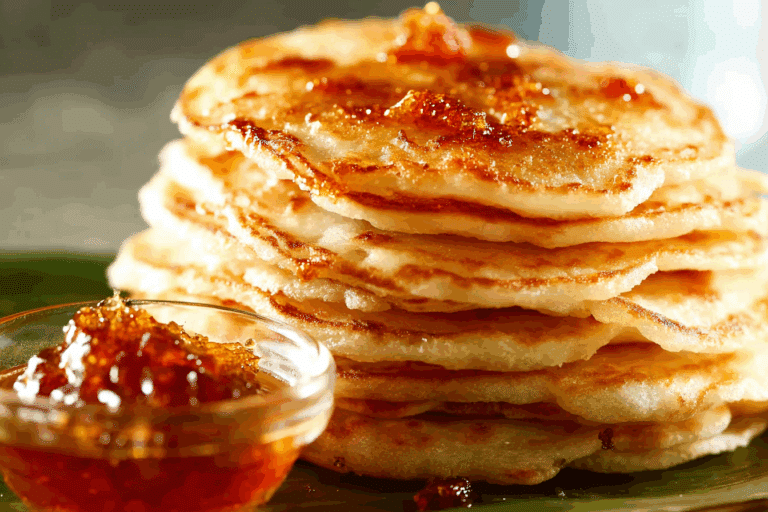
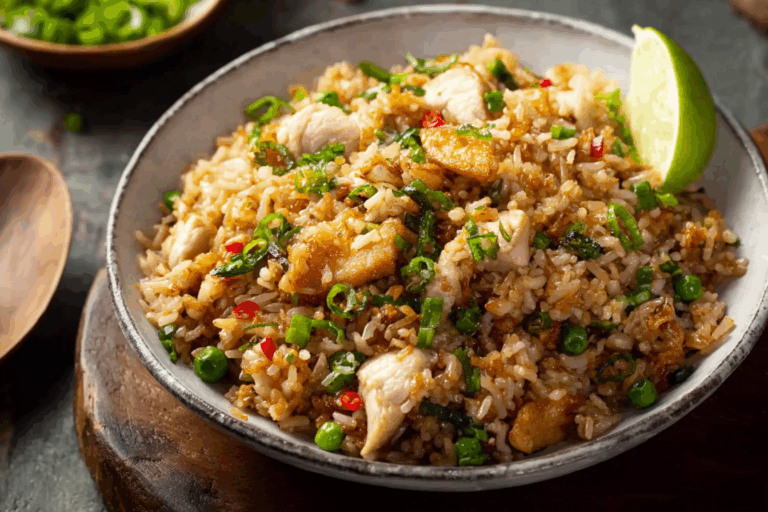

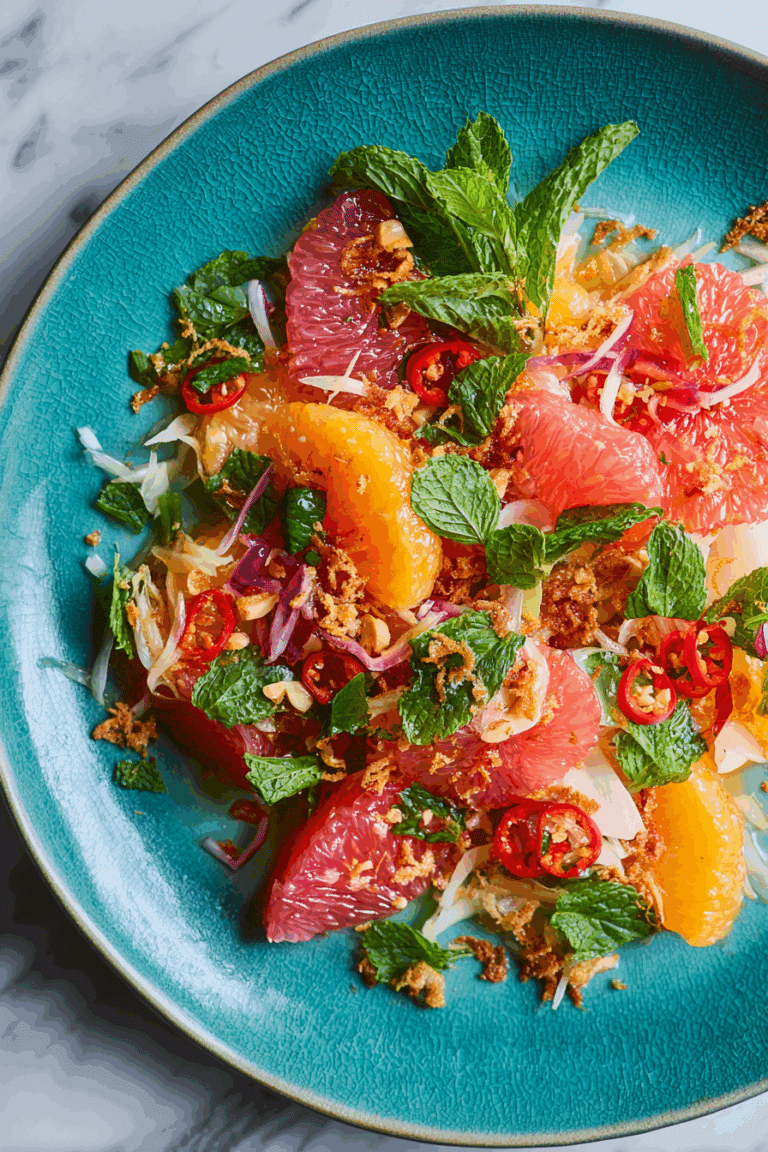
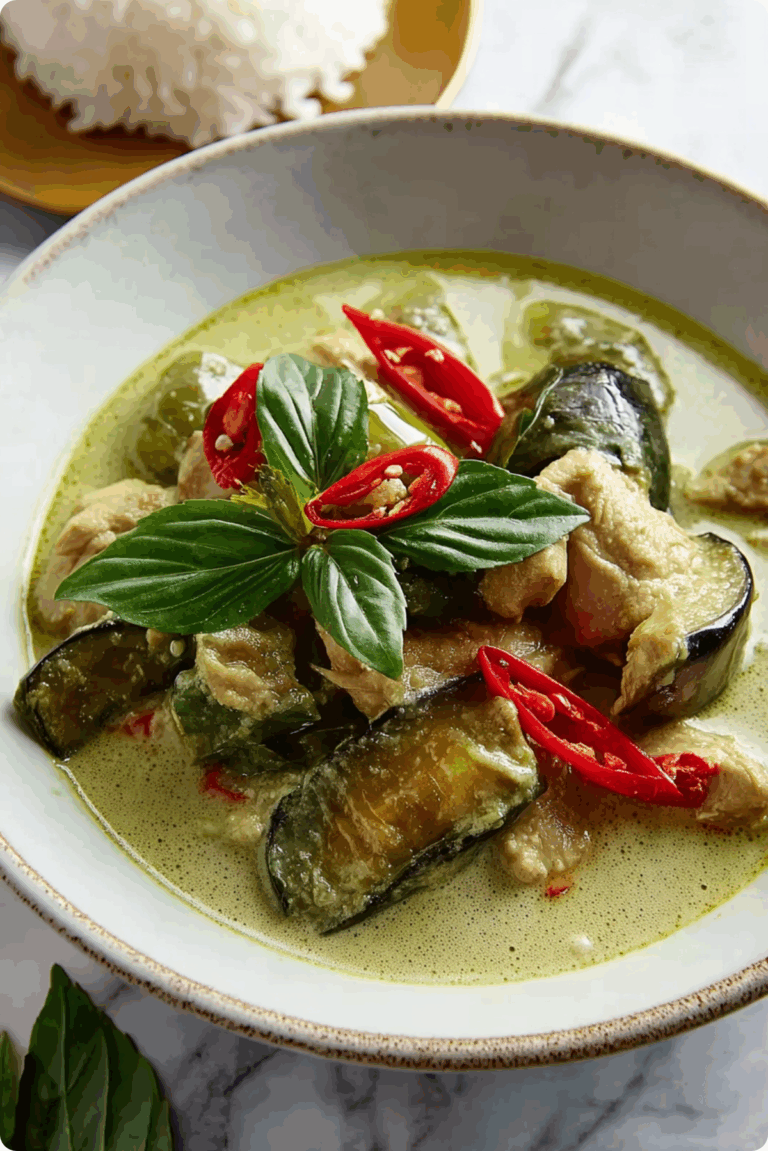
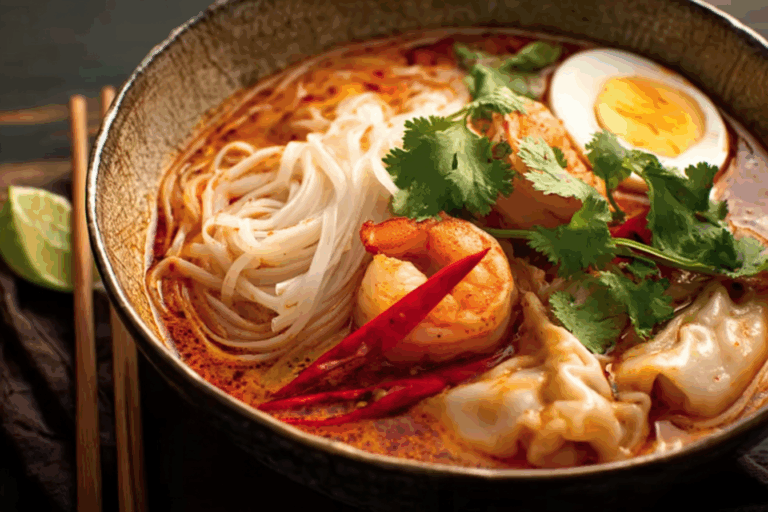
Great post. I am facing a couple of these problems.